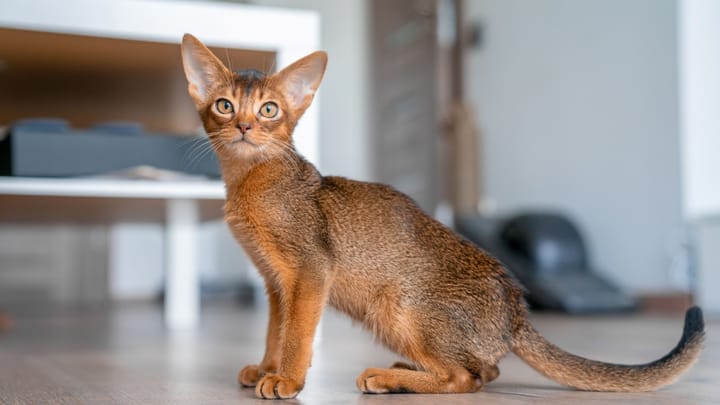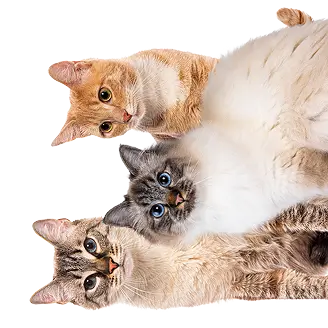Abyssinian Cat
Other name: Bunny cat


Some people say these cats are the spitting image of the Felis Iybica, the ancient African ancestor of the modern domestic cat. Others say their face, large ears, almond-shaped eyes and the colour of their coat must have been the inspiration behind many paintings and other artwork from Ancient Egypt. Their genetics, however, indicate that they also had South-East Asian ancestors. Regardless, the Abyssinian is a breed as magnificent as it is ancient, whose characteristic colour and regal appearance are the perfect match for their endearing personality and abundant energy.
|
Life expectancy |
The Abyssinian Cat has a life expectancy of between 13 and 15 years |
|
Temperament |
|
|
Adult size |
Female
Approximately 12 in
Male
Approximately 12 in
|
|
Adult weight |
Female
Between 7 and 9 lb
Male
Between 9 and 11 lb
|
|
Coat colour
Hare/ruddy, cinnamon (also called sorrel/red), blue, fawn The Bunny Cat’s characteristic colouring is due to the Agouti gene. This gene separates the colour pigments along the length of the hair, resulting in alternate pale and dark bands on each hair. So for the hare colour, the fur is made up of alternating bands of red-orange (hot apricot red) and black or very dark brown, reminiscent of a hare’s coat in summer. The cinnamon colour is a mixture of light apricot and dark cinnamon, not unlike a puma’s coat. Blue and fawn coats are a dilution of the hare and cinnamon colours. Abyssinians can also be other colours such as chocolate, lilac and ginger. All these colours can fade to silver if the gene is present. |
Brown Red Cream Blue |
|
Type of coat
Short |
Short |
|
Eye colour
Gold / yellow, hazel, copper, green. |
Green
Yellow
Brown
|
|
Purchase price |
The Abyssinian Cat costs approximately 300£ |
The coat colour of each cat is completely unique, due to the variable distribution of pigments throughout their fur.
More details about the Abyssinian Cat
Abyssinian Cat: Origins and history
Although this cat’s exact origins are unknown, mysterious even, we do know that the first Abyssinian reported in Europe was in the 1860s, after the Anglo-Abyssinian War. The country that would later become Ethiopia was called ‘Abyssinia’ at the time, and this new breed of cat was named in honour of its country of origin. English breeders worked to refine and standardise the breed’s appearance, coat and physiognomy, notably by making crosses with the British Shorthair and other short-haired cats. The breed was recognised in England at the end of the 19th century and some of its members were exported to North America in the early 20th century. In 1917, the Abyssinian was officially recognised by the Cat Fancier Association (CFA).
These cats weren’t very popular at first: there are few kittens per litter and they don’t live to be very old. Both World Wars also decimated the breed in Europe, with Abyssinians nearly disappearing completely. It is said that there were only 12 of them left in England after World War Two. Fortunately, the combined efforts of American and European breeders restored nobility to the Abyssinian, and it is now one of the most popular breeds.
Physical characteristics of the Abyssinian Cat
Abyssinians are average size and ‘foreign’ build, meaning they have a narrow overall structure. They are athletic, with well-defined muscles, but never heavy, with a build and posture that give the impression that they are constantly on the verge of jumping. These cats move with lightness and elegance, always appearing as though they’re on the tips of their toes. Their well-proportioned and proudly-held head, along with their long tapered tail further accentuate the suppleness and fluidity of these little house pumas. Their big, almond-shaped eyes, neither round nor narrow, are shiny and expressive. Their large cup-shaped ears, with a flared base, sit quite low on their head and when pointed forward, give them a very attentive look.
Abyssinian Cat: Characteristics
Abyssinian Cat: Behaviour
Breed compatibility Abyssinian Cat
Abyssinian Cat: Purchase price
The average purchase price of an Abyssinian is about £300, with price varying according to lineage, breeding reputation, age, sex, etc. For your monthly budget, you should allow around £25 per month to meet their needs, in providing a quality diet and ensuring they are kept in good health.
Abyssinian Cat: Health
The life expectancy of the Abyssinian is on average 13 to 15 years.
Although these cats are short-haired, their undercoat gives them some moderate resistance to cold and heat.
Any extra weight will show up very quickly on the Abyssinian’s svelte little body, but if they stay active this shouldn’t be a problem you encounter.
Although Bunny Cats can develop all the same conditions found in other domestic cats some day or another, certain genetic diseases are slightly more common:
- Pyruvate kinase deficiency, which causes anaemia (genetic testing is available)
- Progressive retinal atrophy, which causes blindness (genetic testing is available)
- Amyloidosis, which leads to irreversible renal failure following the build-up of amyloid in the body (no genetic test exists yet, but the disease is retreating due to breeders’ cautiousness and vigilance)
They are also somewhat susceptible to periodontal disease (gingivitis and tartar), so paying close attention to the dental care they need is recommended.
On the whole, however, this breed generally has good health.
The number of kittens per litter is 3 on average, which is fewer than most other breeds of domestic cat. Kittens are born bicoloured, with the ticking of their fur not appearing until around 6 weeks. It takes a year to a year and a half for their final colour to settle.






